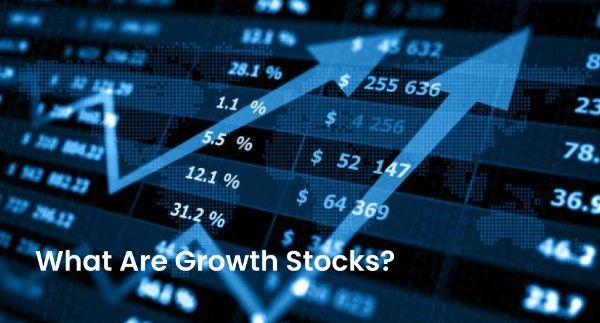What are Growth Stocks?

The Bombay Stock Exchange (BSE) and the National Stock Exchange (NSE) have thousands of companies listed for trading. These stocks are not all the same. Depending on the stage of the issuing company, its financial strength and prospects, the listed shares can be grouped into different categories. Among these categories is one that includes growth stocks.
What are they, which investors are they suited for, and should you invest in growth stocks? Let us find out.
Growth stocks are the shares of companies that are in the early or initial stages of their journey. In this phase, growth is the most important goal for any entity, which is why their shares are often dubbed growth stocks. When you invest in such stocks, your primary way of earning would be from the potential capital appreciation in the company’s share price.
Companies whose shares are classified as growth stocks typically reinvest their profits in the business to fuel growth and accelerate capital appreciation. This is quite different from how established companies use their profits. Such companies may pay out a part of their net gains to shareholders because they have already achieved significant growth.
The Key Features of Growth Stocks
Growth stocks are defined by a few key characteristics that separate them from value stocks. Check out these key features of growth stocks below.
High Price-to-Earnings Ratio
The price-to-earnings (P/E) ratio compares the current market price of a company with its earnings per share (EPS). Growth stocks generally have a high P/E ratio because investors are willing to pay a premium to hold shares in such companies, owing to their high potential for growth in the future.
High P/E-to-Growth Ratio
The P/E-to-growth ratio builds upon the P/E ratio and gives you clarity about a company’s growth prospects. As the P/E-to-growth ratio meaning indicates, this metric compares a company’s P/E ratio with its annual EPS growth rate. Growth stocks may generally have high PEG ratios. However, if the EPS growth rate is high, the ratio could be low.
Profit Reinvestment
Another defining feature of growth stocks is that they rarely, if ever, pay dividends. This is because companies in the initial stages of growth tend to reinvest all of their profits in the business. This helps facilitate further growth, which is a key characteristic of growth stocks. However, investors may have to forego dividends for a few years.
Strong Growth Potential
The best growth stocks are marked by a distinctly high potential for growth. The companies issuing such stocks may report increasing revenue, growing profits and rapid expansion. In addition to company-specific factors, the industry or sector in which such companies operate may also be poised for high growth in the future.
Why Should You Invest in Growth Stocks?
Now that you know what the best growth stocks entail, let us discuss the top benefits of including such stocks in your portfolio. Here are the main reasons to invest in growth stocks.
Potential Capital Appreciation
When you invest in growth stocks, you get the benefit of potential capital appreciation over the long term. This is because companies that have issued such stocks are typically growth-focused and their share price may increase by several multiples over a few years. If the share price does increase, you can earn significant profits.
Opportunity to Capitalize on Early Growth
Most companies in the initial stages of their growth are at the forefront of sectoral and industry-specific innovation. By including the stocks of these companies in your portfolio, you can benefit from the early growth of these entities. Often, this is the most rapid stage of growth in a company’s life cycle.
Compounded Growth
Many growth companies reinvest their profits back into the business rather than paying dividends. This reinvestment can lead to accelerated growth and potentially compound the returns over time. As the company expands its market share and improves profitability, the stock price may also continue to climb, thus maximizing long-term wealth accumulation.
Portfolio Diversification
Including growth stocks in your portfolio can provide some much-needed balance and diversification. While these stocks may increase the overall volatility in your portfolio, they also offer the potential for higher returns. This can be particularly beneficial when combined with more stable and value-oriented investments.
Risks Associated with Growth Stocks
Investing in growth-oriented stocks is not without its risks. The main limitations of these stocks include the following aspects:
Higher Volatility
Growth stocks may experience significant price fluctuations, making them more volatile than the stocks of established companies. This volatility may lead to significant short-term losses, which could test your resolve and tempt you to sell your holdings. Such volatility may be particularly stressful for risk-averse investors.
Overvaluation Risk
The stocks of growth companies may frequently trade at high valuations based on future earnings potential rather than current financial fundamentals. This may lead to inflated prices that may not be justified by the company’s actual performance. If the expectations for growth are not met, the stock price could dip sharply.
Lack of Dividends
Most growth companies invest their profits back into the business rather than paying dividends. This means you will have to rely solely on capital appreciation for your returns. During market downturns or periods when the company underperforms, the lack of dividend income can make these stocks less attractive.
Conclusion
Before you invest in the growth of a company, you must thoroughly analyse the entity’s prospects, its sectoral and industry specifics and its key fundamental ratios. Only then you can find the best growth stocks for your portfolio. For such in-depth analysis, you need access to up-to-date financial information and key ratios.
If this is what you seek, the Motilal Oswal Research 360 platform can be your new best friend. With comprehensive details about every listed company — including the company’s overview, its financials, key technical indicators, SWOT analysis, related news and competitor comparison — the Research 360 platform makes it possible to thoroughly evaluate growth stocks from the comfort of your mobile or laptop. Check out the features on this platform today to upgrade your stock market analysis.

















